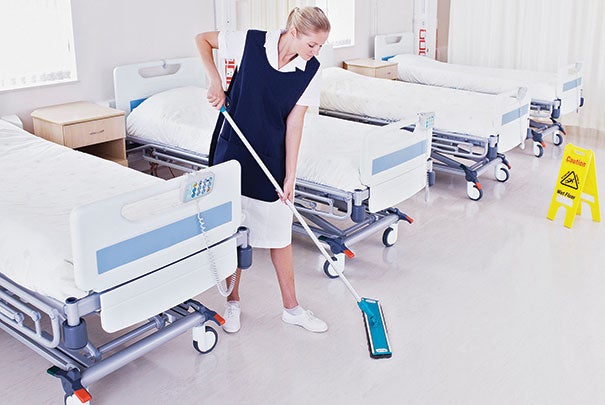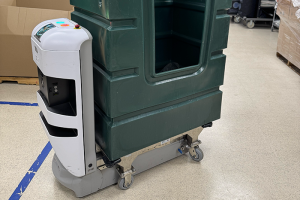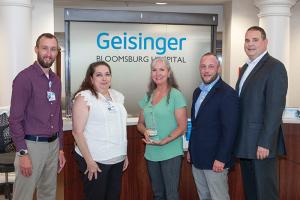Optimizing environmental services staff
 |
|
PHOTO COURTESY OF HILLYARD INC. Color-coded microfiber flat mops can improve cleaning effectiveness in patient rooms with hard floors. |
A typical housekeeper will spend two or more hours each day on such non-cleaning activities as traveling to the supply or linen closet, running errands for the supervisor, performing computer or paperwork, setting up equipment, donning personal protective equipment and restocking his or her cart.
Annualized, the non-cleaning time for a typical housekeeping staff can be in the hundreds of thousands of dollars of lost productivity per year.
Understanding the process that the environmental services (ES) department follows in each area of the facility is critical to maximizing the performance and productivity of its staff. For instance, properly stocked custodial carts and runners to restock these carts can help to minimize travel time for the housekeeping staff.
Operational efficiency and process management are key to controlling costly non-cleaning time.
About this series
This series of tutorial articles is a joint project of the Association for the Healthcare Environment and Health Facilities Management. |
Labor-efficient techniques
Studies show that labor is approximately 80 percent of an ES budget. Chemicals, consumables, staff training and equipment make up the remainder of the maintenance budget, so it’s imperative to use the most labor-efficient techniques in the cleaning industry.
Because some of these techniques are equipment-based, using the right cleaning equipment will save labor costs. Rider automatic scrubbers, backpack vacuums, touch-free restroom cleaning machines and microfiber equipment are considered best practices due to the amount of labor savings they achieve compared with traditional cleaning.
Beyond equipment, a good workloading program also will help to answer labor issues. This is the systematic calculation of a cleaning process to determine the amount of time and staff required to clean a facility. Every floor type and fixture for each room is recorded. Each room in the hospital is also recorded as part of an area type, and each area type has a defined set of tasks that are required for thorough cleaning.
A standard task time and frequency is applied to each room to determine the total number of hours needed to clean the facility. The time standards from the program are then summarized by facility, area, room and zone to help determine if the facility has the correct number of staff to clean and if there is the proper balance of staff throughout the day.
One of the most challenging aspects of the workloading process is identifying the accurate cleanable square footage. It may seem like a daunting chore to document every room, floor type and fixture in a facility to determine the appropriate staffing levels but, in most facilities, there is software available that already has captured this information. ES managers can check with their respective organization’s business office, architect or maintenance department to see if they are using building information modeling (BIM) software. A digital database that represents the building in 3-D, BIM is used in the design and construction of most facilities. It now can be used to manage, operate and maintain a facility into the future.
Other software systems commonly used to store cleanable surfaces data are computerized maintenance management systems or space inventory management programs. The electronic facility data then can be transferred into the workloading program to start the analysis on the cleaning program. While the electronic transfer of data will save time in counting and measuring a facility, the room data must be reviewed by an ES staff member to verify that it is accurate and up-to-date. Incomplete or inaccurate room data input will result in a flawed facility assessment and misguided labor assumptions.
You may also like |
| Improving HCAHPS scores with ES workers |
| Achieving optimal hospital cleaning efficiency |
| ES teams lean on technology for performance |
|
|
If none of these electronic transfer options are available, the facility can pay a contractor to measure facilities based on square footage. Some custodial suppliers provide this as a value-added service. Parts of the facility undoubtedly will need to be measured by hand, but a laser distance-measurement tool will speed up this activity. After the facility data have been entered into the workloading program, the cleaning analysis on tasks and frequencies by area can begin.
Workloading software can determine the proper number of full-time equivalents (FTEs) needed to clean the facility. It will list the tasks and frequencies by room type to calculate the daily FTEs required. The software also can determine the areas of the facility that are the most expensive in terms of labor allocation, such as patient rooms. Cleaning productivity rates will vary by area type within the facility. For example, a surgical suite can be cleaned at the rate of approximately 425 sq. ft. per hour, whereas a conference room can be cleaned at a rate of 3,000 sq. ft. per hour.
The key is to know exactly how many square feet of both direct patient care and non-direct patient care one is responsible for cleaning, because the cost to clean each is very different. Other factors that drive up labor costs in ES and need to be properly managed are the number of patient discharge cleanings. While each day’s cleaning requirements can be different due to the number of surgeries, specialized patient rooms and patient discharges, the software needs to be flexible enough to calculate the daily FTE requirements accordingly.
After the correct number of daily ES staff is determined, the next step is to determine if the staff members are properly allocated. This is called workload balancing. The premise is to close the gap between the available time to clean with the required time to clean the facility.
For example, after breaks and non-cleaning time are subtracted for one eight-hour employee, there are 400 minutes left to clean per day. This would be the available minutes to clean. The required minutes to clean are determined from the daily needs of the facility, such as patient room discharges, routine patient room cleaning, emergency room cleaning, restroom cleaning and office cleaning.
If it takes 45 minutes to clean a discharged patient room, a 400-minute employee couldn’t be assigned to 10 discharge cleanings, plus side work and all the patient hallways in his or her area. There isn’t enough time available to physically complete the work assignment. Many ES departments base staffing assignments on employee feedback, manager experience or other non-value-based data. Without workloading software, the manager will not know if the assigned minutes to clean equal the housekeeper’s available minutes to clean [see sample table of a daily work load above].
Labor reports help ES managers to allocate staff properly to achieve fair and balanced workloads for each shift. Supervisors also can boost employee morale by showing that everyone has the same amount of work and no one individual is receiving less work due to perceived favoritism. Workload balancing reports are available through a custodial consultant or a custodial supplier.
Tools for training
A key component to workloading is using the appropriate cleaning tasks by area type. How does an ES manager verify that each employee has received the proper level of training in best practices for his or her area of responsibility? The plan should consist of classroom teaching, workshop-style learning, online training and on-site training for customized site-specific needs.
Custodial suppliers may offer on-site training sessions on how to properly use their products and equipment. This should be done at least once a year. It ensures that the ES staff are up-to-date on new products and the most effective cleaning technologies. Custodial vendors also can verify that past product consumption is in line with the size of the facility. They should be able to provide benchmark reports on the facility compared with like-size facilities in the geographical area.
A learning management system (LMS), a popular tool in ES training, is for the administration, documentation, tracking, reporting and delivery of training programs. Because it is available 24/7, it can be utilized at the employee’s convenience. The flexibility and convenience of e-learning tools are necessities for today’s fast-paced workforce. Learning paths can be assigned to each staff employee to ensure that all have acquired the appropriate skills to do their jobs effectively. The online classes are offered in video format so that the employee can see how to properly clean each area in the facility. Then they are given an online test to show that the employee has retained the knowledge and passed the requirements of each key area in a facility.
Once the employee passes the course, the manager is notified by email and the LMS updates the training system with the score and employee’s name. Detailed and summary reports can be run at any time to see where the employees are in relation to their established learning paths. This is a great way to document that ES staff are properly trained. The LMS can be used for training on any topic such as human relations, regulatory compliance and safety. ES leaders are realizing that online learning programs can greatly reduce training costs.
Standardized training clearly identifies the expectation of what needs to be cleaned and simplifies the cleaning process. Each room should have a defined list of tasks, frequencies and products to be used during cleaning, and all employees should be trained the same way using the same materials and guidelines. When the training is standardized across all shifts, the cleaning results are more dependable and predictable.
Job cards, process flow charts and product wall charts are common tools used with a standardized training program. These programs can be incentives to help ES departments find and retain skilled talent. Standardized training raises the level of professionalism within the department and raises employee morale by creating a clean, healthy and safe facility.
A critical component for any workloading program is the ability to measure the cleaning program that has been implemented. Making it easy to manage, monitor and take corrective action is critical to delivering clean, healthy and safe buildings at the lowest total cost.
A quality control (QC) program should be simple, intuitive and flexible to use. It should be easy to implement and should sustain an ongoing cleaning program that continuously improves outcomes and cleaning results.
A QC program should be able to record the deficient rooms and measure the historical performance by area, room and employee. A QC trending report is essential to communicate and implement corrective action in any substandard areas. The goal is to manage performance, increase accountability and improve results.
Significant impact
ES leaders continuously strive to do their jobs better, faster and within budget.
With reduced government funding, value-based purchasing and HCAHPS measurements used to determine hospital reimbursements, the correct ES labor staffing equation can have a significant impact on a hospital’s operational costs.
Obtaining and using the right tools should be a top priority.
Bill Grimwood is cleaning-cost analysis program director at Hillyard Inc., St. Joseph, Mo. He can be reached at BGrimwood@Hillyard.com.




